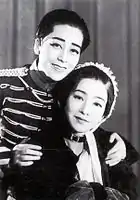Keiko Sonoi
Keiko Sonoi (園井 恵子, Sonoi Keiko, 6 August 1913 – 21 August 1945) was a Japanese actress, who was a member of the all-female musical-performing Takarazuka Revue during the 1930s and the 1940s, best known for her role as an officer's widow in the wartime film Muhōmatsu no isshō (1943), and for being part of the Sakura-tai or Cherry Blossom Unit of traveling shingeki play actors who died as a result of the 1945 Hiroshima bombing.
Keiko Sonoi | |
|---|---|
園井恵子 | |
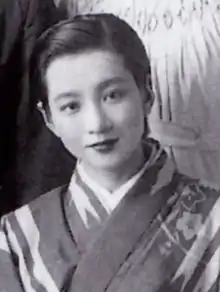 Sonoi in her Takarazuka days | |
| Pronunciation | Sono'i Kei'ko |
| Born | Tomi Hakamada (袴田トミ) August 6, 1913 Matsuo, Iwate (now Hachimantai) |
| Died | 21 August 1945 (aged 32) Kobe, Hyogo |
| Nationality | Japan |
| Other names | Kiyono Kasanui (笠縫清乃)[1] |
| Alma mater | Takarazuka Revue |
| Occupation | actress |
| Years active | 1930–1945 |
| Known for | film, theatre |
Notable credit(s) | Muhōmatsu no isshō (1943, Daiei Film) |
| Height | 155 cm (5.09 ft) |
The fate of the Cherry Blossom Unit was later dramatized by playwright Hisashi Inoue, and also made into a feature film by director Kaneto Shindo.
The actress appears to have had a long-held desire to perform shingeki plays, but that was not economically viable due to the need to her support her parents and siblings. As a Takarazienne, she had the manga comic artist Osamu Tezuka as a childhood fan who lived on her block, and Astro Boy may have been influenced by Sonoi's performance of Pinochio ("Pinocchio") from April to May, 1942.
Biography
Early life
Keiko Sonoi was born Tomi Hakamada (袴田トミ, Hakamada Tomi) on 6 August 1913 in Matsuo, a village in Iwate Prefecture. She was the first-born daughter of Seikichi Hakamada (袴田清吉) and his wife Kame (カメ), who both ran a business that made and sold sweets.[2][3]
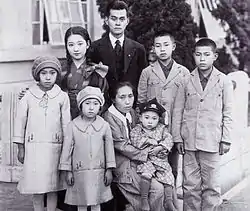
She moved to Morioka to stay with her uncle Tasuke (多助)'s family,[lower-alpha 1] in order to attend the "upper elementary school" there.[lower-alpha 2][5][3]
Later, she and her uncle moved to Otaru, where she attended Otaru Higher Girls' School.[5][3]
Her real name was "Tomi", as officially registered in her koseki (family register). But during childhood, this name provoked the taunting of other children, who chanted the line iyasa, Otomi (いやさ、お富) from the kabuki play Yowa Nasake Ukina no Yokogushi. She therefore decided to re-christen herself Hideko (英子), by which she was exclusively known as during her time in the Takarazuka Revue.[6] She later called herself Masayo (真代), and her last letter, written four days before her death, was signed with that name.[7] She allegedly chose these aliases from being immersed in onomancy (seimei handan), a type of fortune-telling based on the name.[8]
Takarazuka aspirations
She learned of the existence of the all-girl Takarazuka Revue through girl's magazines, and by the time she graduated (upper) elementary school, she wished to join this musical revue theatrical company, but this was foiled when her mother opposed the decision.[3][9]
During the time she attended the Otaru high school, she had opportunity to see a musical revue/musical play (歌劇, kageki) for the first time in her life.[lower-alpha 3][10] Her determination to join Takarazuka remained steadfast, and after dropping out of high school, she entered the Takarazuka School of Music and Musical Theatre (Takarazuka Ongaku Kageki Gakkō) in March 1929.[11][8]
A rather different perspective is taken by other sources, according to which Sonoi as a high schooler went to see a proletarian shingeki play put on by the Tsukiji Shōgekijō (Tsukiji Little Theater) performing on road in Otaru, and thenceforth, her true aspiration was to perform as shingeki actor.[lower-alpha 4] However, that would be a road to economic hardship, and instead she entered the Takarazuka School, which paid even first-year students (yoka-sei) a 10 yen (or 15 yen[15]) monthly salary, most of which she would send to her family.[12][14][lower-alpha 5]
One of the principal actors at the Tsukiji Little Theater was Sadao Maruyama,[20] and Keiko Sonoi later did indeed retire from Takarazuka to become a shingeki actor under Maruyama's direction.[21][22]
As a student she earned the nickname Hakama from her real name Hakamada, [23] and was particularly close to her roommate Hisako Sakura.[24]
Takarazuka Revue
In 1930, she became second-year student (yoka-sei) and was now a performing member of the 19th class.[1] She was assigned to the Hana-gumi (花組, "Flower Troupe") group, and initially performed under the stage name of Kiyono Kasanui[1] making the stage debut in Haru no odori in April. She changed her stage name later that year to Keiko Sonoko.[8][11]
After graduating in 1931, she was assigned to the Tsuki-gumi (Moon) then moved to other troops.[25] In October, she was cast as the old gate-keeper lady in Tetsuzo Shirai's Lilac Time, and was praised as "the greatest (fruit of my endeavor) this year" by Ichizō Kobayashi, the head of the Hankyu-Toho conglomerate.[26]
Typecasting
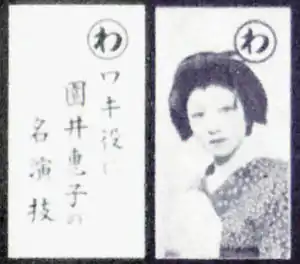
She became recognized as a skilled and versatile supporting actress, especially in comedic roles.[27] Her close colleagues Hisako Sakura and Kuniko Ashihara recalled that she excelled in her role as Frédéri's mother in Aruru no onna (1934), which was the Takarazuka adaptation of L'Arlésienne.[29] Other comments include: "Not flashy but giving a 'flavorful' performance"(Yoshio Sakurauchi, politician well known as zuka-fans), "Skillfully executes cheery, witty roles" (Ken Harada, another politician), "Skillfully executes cheery, witty roles" (Issei Hisamatsu, Takarazuka stage director and writer).[30]
Because she was considered too small of stature for male roles, but largish for female roles, she became type-cast for the sanmaime (a short-of- handsome, comic male) or elderly role. Even though one Takarazuka director, Chōken Maruo asserted that the Revue had precious few sanmaime talents, and "only the truly skilled can execute sanmaime parts", Sonoi herself despised being called sanmaime.[30]
Takarazuka Films
In 1938, Takarazuka Films was established, and she was cast in several of its movies, until the production company was forced to shut down in 1941 as the war-times situation turned more serious. She appeared in Gunkoku jogakusei ("Female Students of a Military Nation", 1938), Yama to shōjo ("A Mountain and a Girl", 1939), Yukiwarisō ("Primrose" 1939), Minami jūjisei ("Southern Cross", 1941).[31][32]
Playing outside repertoires
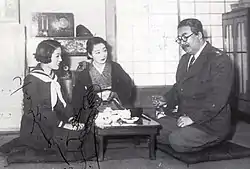
In January 1941, Sonoi and Toho Studio movie star Hideko Takamine made guest appearances in theatrical productions by comedian Roppa Furukawa's company in Tokyo.[lower-alpha 6][34][33] This received notice as the first time a current Takarazuka member was seconded to appear on stage elsewhere.[35] According to some sources, Sonoi was specially picked out by playwright Kazuo Kikuta who wrote for Roppa's troupe; Kikuta had already regarded Sonoi as a promising talent and insisted she be cast in his Sekijūji-ki wa sususmu at Takarazuka in 1940.[34][35]
Leaving Takarazuka
Around this time, Sonoi had already indicated her inclination to convert to Shingeki acting. Correspondence from Jūzaburō Yoshioka at the Tokyo Takarazuka office[lower-alpha 7] shows that management was aware she "wanted to do plays like the Tsukiji" (Tsukiji Little Theater, i.e., shingeki plays), but Yoshioka suggested she settle for performing with Roppa for the time being.[34][36]
In the end, she would not be persuaded to remain, and after starring as the original cast lead in Pinochio (ピノチオ, "Pinnochio", April– May, 1942), Sonoi resigned from Takarazuka Revue. Shigenori Utsumi who wrote the script later recalled being stunned by this choice of casting,[37] but Yachiyo Kasugano, long-lived doyenne of Takarazuka, revealed that she had been tapped for the part, but lobbied to cede the role to Sonoi after learning of her imminent departure.[38]
The Takarazuka Revue tried to retain her by offering her terms that would allow her some leeway to perform in film or shingeki theater, but the compensation and performing restrictions they offered were unsatisfactory, according to her correspondence to Shizu Nakai.[39][lower-alpha 8]
Film role in Matsu
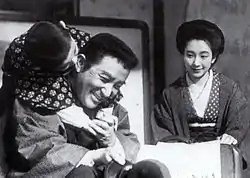
In 1943, Sonoi was cast opposite top leading actor Tsumasaburō Bandō in Muhōmatsu no isshō, where she played Mrs. Yoshioka, whom Muhōmatsu (or Matsu the Untamed, played by Bandō) becomes romantically but unrequitedly attached to.[lower-alpha 9][41][42] The film became a box office hit.
The child actor billed as Akio Sawamura (actor Hiroyuki Nagato of later years) said he earnestly wished he could marry a woman like Sonoi.[8]
The director, Hiroshi Inagaki recalled that Takako Irie and Fukuko Sayo had been the first choices for the role but were not available,[43] and the offer was made to Sonoi on Sayo's recommendation.[44][45]
Due to success of this film, Daiei offered Sonoi a studio contract, but she declined saying she preferred to continue studying with her theatrical company, Kuraku-za (cf. below).[46][47] The director, Hiroshi Inagaki was eager to sign Sonoi onto his new projects at the time;[47][44] in later years, the director reflected that Sonoi was "not so much a skilled performer as someone with a passion for performing. She had the basics of inhabiting the persona of her role, down pat".[45]
Non-musical theater
The theatrical troupe Kuraku-za (苦楽座, "Pleasure and Pain Company") was formed afterwards,[20] on July 8, 1942 (2 months prior to Sonoi leaving Takarazuka) by Sadao Maruyama and others, namely Tokuemon Takayama (Kenji Susukida), Keita Fujiwara (Kamatari Fujiwara), and Musei Tokugawa.[46] Of the initial run of three plays, Sonoi was cast in Genkanburo ("entryway bath").[34][46] She continued performing for the troupe, appearing in Yume no su ("Dream's nest", 2nd run, June 1943 at the Hōgakuza), Eien no otto ("Eternal husband". 3rd run, January 1944 at the Kokumin Shingekijo[lower-alpha 10]).[25][46]
Sonoi played the widow's role as in the movie when the troupe produced the theater adaptation of Muhōmatsu no isshō, first in Kuraku-za's 4th run at Hōgakuza in October 1944, after which the troupe took this play on the road, traveling through a large part of Western Japan.[25][46]
After the regional tour finished in December, the bombing raids intensified in Tokyo and food procurement became difficult. The Kuraku-za decided to disband, but Maruyama suggested the members regroup as a traveling troupe with the objective of comfort-visiting (慰問, imon) the populace beleaguered by war, and twelve other actors joined. They came up with the name "Sakura-tai" for the new troupe while they were at the Tsunagi Hot Spring in Sonoi's hometown of Morioka, Iwate, rehearsing for Shishi ("Lion", written by Jūrō Miyoshi). But this name was not made official until June 1945 after they became stationed at Hiroshima.[46][49]
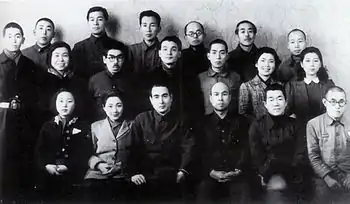
The mobile troupe was only able to do a grand tour briefly, from January to March 1946, travelling to parts of the Kanto area and then Hiroshima. In Kanto they mainly visited manufacturing plant workers, but in Hiroshima they "comfort-visited" wounded soldiers as well.[53] The Nihon Ido Engeki Renmei (Japan Touring Theatre League) then instructed all troupes to cease touring city by city, and perform in the confines of an evacuation (sokai) area. It was decided Kuraku-za would be assigned to stay in Hiroshima[54] or its vicinity.
Hiroshima
The choice of Hiroshima as their evacuation zone was a source of consternation for members, because the city remained relatively unscathed despite its military strategic importance, and a major strike was thought imminent.[54] Sonoi wrote in April stating that she tried to refuse going to Hiroshima and remain in Tokyo (which had been incinerated in the March bombing), but was pressured to change her mind.[lower-alpha 12][55] Also while she was still at Tokyo, she went to the Toho Studio office asking if there were any film roles for her, which she wanted to take to extricate herself from touring under heavy bombardment. In fact director Kajirō Yamamoto was hoping to cast her in his new film (Kaidanji) but the office replied no, and she had left.[56][57]
The Kuraku-za's mobile unit, now officially renamed Sakura-tai (櫻隊, "Cherry Blossom Unit"[20]) reached Hiroshima on June 22.[58] From July 5, they toured the San'in region.[59][60] Due to illness,[lower-alpha 13] the troupe returned to Hiroshima prematurely ahead of schedule.[lower-alpha 14][62] This marked the end of performance by the Sakura-tai.[63]
Members either dropped out of Sakura-tai or left Hiroshima, so that in August only 9 members remained at their office in Hiroshima.[64] Sonoi spent time recuperating in Kobe (at the home of Shizu Nakai and husband Yoshio) August 2 to August 5, returning to Hiroshima on the fateful day.[65]
Thus Sonoi, Maruyama and others were in Hiroshima when the Atomic Bomb was dropped on August 6, 1945. They both succumbed to the aftereffects shortly thereafter.[66]
Hiroshima A-bomb
When the Atomic bomb was dropped on Hiroshima, Sonoi was thrown from the hallway to the yard by the blast, and momentarily lost consciousness, but otherwise had no visible wounds. She found actor Shōzō Takayama (son of Kuraku-za co-founder Tokuemon Takayama aka Kenji Susukida) lightly injured, and the two of them fled to Mount Hiji approximately 1 kilometre (0.6 mi) away. Sadao Maruyama and Midori Naka also left the scene, each separately, but were in poor condition were taken into custody at different locations.[lower-alpha 15] The remains of the five others members were found skeletonized at the burning wreck of the office.[65]
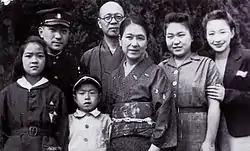
Sonoi and Takayama subsequently took the train and reached the Nakai residence in Kobe.[lower-alpha 16] Sonoi's face and clothing were soiled, and she wore a jika-tabi on one foot and a man's shoe on the other, so that she looked "like a beggar" and was nearly beyond recognition.[69][68]
On August 15, when informed the war had ended, Sonoi expressed her gladness at being able to act to her hearts content to Akiko Utsumi who was visiting,[lower-alpha 17][69] and also wrote a letter dated August 17 to her mother Kame in Morioka expressing this sentiment.[70][7]

However, Sonoi's condition deteriorated. Her hair started to fall off at night, before suffering high fever around August 19, according to Mrs. Nakai;[71] Other symptoms such as hematochezia, internal bleeding and delusions also presented.[70][69]
By August 19, Motoo Hatta who was a stage director for Sakura-tai tracked Sonoi down, and came to see her at the Nakai residence.[lower-alpha 18] Sonoi asked of news about Maruyama, and sensed he must have passed away.[72][68] On August 21, Sonoi's fever reached 40 degrees C, and Mrs. Utsumi rushed out to procure ice. Sonoi felt the coolness of the chilled gauze, and said "Oh, how good it feels". Those were the last words she uttered before she died.[69][73]
Sonoi's remains were cremated the following day,[69] and her bones and ashes buried in Onryū-ji in Morioka.[8][65]
The story of the Sakura-tai's demise was written up in a book by author Hagie Ezu in 1980, which was adapted into the film Sakura-tai chiru (1988) directed by Kaneto Shindō.[74][75][lower-alpha 19]
Legacy
- Influence on Tezuka's art
The childhood home of manga artist Osamu Tezuka in Takarazuka, Hyogo belonged to a row of houses dubbed "Musical Theater Tenements" (Kageki nagaya), and Tezuka recalls that Keiko Sonoi lived at the end of this block.[lower-alpha 20] The manga Ribbon no kishi (Princess Knight) was "totally nostalgia of the Takarazuka Revue", in the comic book artist's own words. He was also a devoted fan of the Takarazuka production of Pinochio (ピノチオ, "Pinocchio", which starred Sonoi), and his Astro Boy may have been influenced by it.[77][78]
- Matsuo village
In 1989 her birthplace Matsuo, Iwate commemorated the centennial of the founding of the village by holding an exhibit of Sonoi's belongings and related printed paraphernalia, publishing a scrapbook compilation entitled Shiryōshū.[79][80]
Related works
- Hagie Ezu Sakura-tai zemetsu (1980), a non-fiction account of the demise of the troupe.
- Kaneto Shindo dir., Sakura-tai chiru (1988 film), based on Ezu's non-fiction. Sonoi was portrayed by Takako Miki.
- Hisashi Inoue's play Kamiyacho Sakura Hotel (first run in 1997). Sonoi played by Kazuyo Mita in the original cast.
See also
Explanatory notes
- The uncle was also a purveyor of sweets.
- Namely, the "Upper Course" (kōtō-ka) at the Iwate Women's Normal School's Attached Elementary School. In pre-war Japan, there was a six-year "Lower Course" followed by a two-year "Upper Course". So this was effectively middle school.[4]
- The show was put on by a company called Shimai-za (姉妹座), billed as a Takarazuka girl's revue, as best as she could recall.
- The play she saw was probably Kaisen ("Sea Battle").[12] This piece as well as the theater group was being treated as taboo even by recent theatrical circles, as according to Miwa Yanagi.[13] Also, the organizer who invited the theatrical company to Otaru was the proletarian novelist Takiji Kobayashi,[14] well-known for being tortured to death by the tokko police in an interrogation as a communist party member and supporter.
- Sonoi's father Seikichi Hakamada had co-signed a loan taken by a kindling and coal company, and when that company failed, Seikichi had to declare himself bankrupt in 1930. The family all moved to Takarazuka, Hyogo to depend on her. Sonoi then had to sustain her family in the place of her ailing father.[18] Juzo Kobayashi, the Hankyu-Takarazuka group's founder and president, learned of her ordeal and once gave her an encouraging letter enclosed with 100 yen.[19]
- At the Yūraku-za theater,[33] operated by the Tokyo Takarazuka Theater Co., Ltd., (which later became Toho). The main Takarazuka Revue company is based in Takarazuka, Hyogo near Osaka/Kobe.
- Yoshiwaka was later to become president of Tokyo Takarazuka; he was also an officer of the parent company.
- Shizu Nakai was a graduate of an older class at Sonoi's high school, Otaru Higher Girls' School, who lived in the Kobe area, and became the president of the high school alma mater organization, which was effectively a support group for Sonoi at Takarazuka.[40] Nakai remained close to Sonoi, and she figures later in the Hirsohima episode (see below).
- A later version (1958) was filmed starring Toshiro Mifune and aforementioned Hideko Takamine.
- This was Tsukiji Little Theater, forced to change its name to Kokumin Shingekijō (People's Shingeki Theatre) due to wartime regulation.[48]
- "X" stands for personnel connected with Fuji's manufacturing plant. Shimaki, Sonoi, Maruyama, Naka, Shozo Takayama became hibakusha in Hiroshima.
- April 1945 Correspondence from Sonoi to Shizu Nakai
- Maruyama coming down with pleuritis.[61]
- And leaving the task of comfort-visit to Sango-za (Coral Troupe) made up of Shinpa actors and Yoshimoto Kogyo performers.
- Maruyama headed for Mt. Hiji but collapsed and was taken by truck to a temporary facility for the wounded. Naka was found in the water of the Kyobashi River where her strength failed her, and was transported to a Tokyo hospital.
- Shizu Nakai whom Sonoi called "(my) mother at Mt. Rokko" lived in Kobe.[67][68] As noted above, Shizu Nakai was from the same high school as Sonoi and a long-time supporter.
- Akiko Utsumi (stage name Machiko Kako) was Sonoi's junior at the Takarazuka Revue; She was by then married to Shigenori Utsumi a writer/director for the Takarazuka Revue.[70]
- Hatta was asked by Sango-za to take along two of its actresses. One of them was Chieko Morokoa, interviewed by the Mainichi Shimbun in the March 2012 article.[68]
- The title of Ezu's book (Ezu 1980) has been variously rendered "Dissolution of Sakura-unit: A theater group's suffering from the atomic bombings"[74] or "Total Annihilation of the Sakura Party, Martyrdom of a Drama Company".[76]
- Or "off of the block". The phrase hazure is ambiguous.
References
- Citations
- According to the parent railroad company's press release (2019). "Takarazuka Kageki no Dendō no kenshōsha ni Takarazuka Kagekidan sotsugyōsei no Sonoi Keiko san ga arata ni kuwawarimasu" 「宝塚歌劇の殿堂」の顕彰者に 宝塚歌劇団卒業生の園井恵子さんが新たに加わります. @press. 2019-04-16.
- Shiryōshū 1991, p. 302.
- Tsuganesawa & Kondo 2006, p. 151.
- Young, Louise (1999), Japan's Total Empire: Manchuria and the Culture of Wartime Imperialism, University of California Press, p. 378, n47, ISBN 978-0-520-21934-2
- Shiryōshū 1991, pp. 1–5.
- Shiryōshū 1991, pp. 113–114.
- Shiryōshū 1991, pp. 146–149.
- Moriuchi, Masashi (December 1980), "Nihon eiga haiyū zenshū joyū-hen" 日本映画俳優全集女優編, Kinema junpō (801): 388–389
- Shiryōshū 1991, pp. 65–71.
- "Osanaki hi no nikki yori" 幼き日の日記より. Kageki, or the Takarazuka Revue. No. 216. March 1938., reprinted in Shiryōshū 1991, pp. 65–71
- Haga, Noboru (1993). "Sonoi, Keiko". Nihon josei jinmei jiten. 日本女性人名辞典. Nihon Toshocenter. p. 611. ISBN 9784820571285.
- Inoue & Komori 2003, Zadankai Showa bungakushi p. 174;[16] reprinted from a piece in Subaru 20 (4), 1998.[17]
- From contemporary art to theater, the artistic quest of Miwa Yanagi (PDF), Japan Foundation, 2013-09-02, p. 6
- Minoru, Kurata (1998-08-31). "Shōwa shoki, Takiji no bungakujō no eii" 昭和初期, 多喜二の文学上の営為 [Kobayashi Takiji. A full-scaled biography]. Jinbun kenkyū. Otaru University of Commerce. pp. 56–57.
- Shiryōshū 1991, pp. 222–224.
- Inoue, Hisashi; Komori, Yoichi (2003). Zadankai Showa bungakushi 2 座談会 昭和文学史二. Shueisha. p. 174. ISBN 9784087746488.
- Ōzasa, Yoshio; Imamura, Tadazumi; Inoue, Hisashi; Komori, Yōichi (1998). "Zadankai Showa bungakushi (6)" 座談会昭和文学史(6)昭和戦中期までの演劇と戯曲--劇作家の言葉と仕事. Subaru. 20 (4): 170, 198.
- Shiryōshū 1991, p. 311.
- Shiryōshū 1991, pp. 16–17.
- Powell, Brian (2013) [2002], Japan's Modern Theatre: A Century of Change and Continuity, Routledge, p. 133, ISBN 978-1-134-24194-1
- Miyata, Shimpachirō (1 July 1965), "In and Around Books", Japan Quarterly, 12 (3): 532–533
- Yokomizo, Yukiko (April 1984), "Interview: Yoshie Minami" インタビュー 南美江, Higeki Kigeki, 37 (4): 90
- Shiryōshū 1991, p. 206.
- Shiryōshū 1991, p. 209.
- Tsuganesawa & Kondo 2006, p. 156.
- Shiryōshū 1991, p. 312; Tsuganesawa & Kondo 2006, p. 153
- Shiryōshū 1991, pp. 122–124
- Ashihara, Kuniko (September 1982), "Shūsen, soshite Sonoi Keiko-san no koto" 終戦、そして園井恵子さんのこと /, Higeki Kigeki, vol. 35 no. 9, pp. 54–55
- Shiryōshū (1991), pp. 204-205, 214, 222-224. Including Ashihara interview.[28]
- Tsuganesawa & Kondo 2006, p. 153.
- Shiryōshū 1991, pp. 324-331.
- Galbraith, Stuart (2008). The Toho Studios Story: A History and Complete Filmography. Scarecrow Press. pp. 29, 33, 49. ISBN 978-0-810-86004-9.
- Takamine, Hideko (1980). Watashi no tosei nikki わたしの渡世日記. Asahi Shimbunsha. p. 263.
- Tsuganesawa & Kondo 2006, p. 155.
- Bungei Asahi, April 1964, pp. 95–97
- Shiryōshū 1991, p. 150.
- Shiryōshū 1991, pp. 24–25.
- Kasugano, Yachiyo (1987), Shiroki bara no shō 白き薔薇の抄, Takarazuka Revue, apudTsuganesawa & Kondo 2006, p. 155.
- Shiryōshū 1991, pp. 137–138.
- Tsuganesawa & Kondo 2006, p. 154.
- High, Peter B. (2003). The Imperial Screen: Japanese Film Culture in the Fifteen Years' War, 1931-1945. University of Wisconsin Press. pp. 163, 500. ISBN 978-0-299-18130-7.
- Muhōmatsu no isshō (2007 DVD, dir. Hiroshi Inagaki) in libraries (WorldCat catalog)
- Kuritsubo, Yoshiki (2001), "Megami—Inagaki Hiroshi Muhōmatsu no isshō (eiga)" 女神--稲垣浩『無法松の一生』(映画) (境界を越えて--恋愛のキーワード集), Kokubungaku kaishaku to kyōzai no kenkyū, a, 46 (3): 68–70; Reprinted (2008) in Shittoku renai no kīwādoshū
- Inagaki, Hiroshi (1981), Sonoi Keiko no hikinuki ひげとちょんまげ - 生きている映画史, Chuokoronsha, pp. 110–112, ISBN 978-4122008304
- Inagaki, Hiroshi (1978), Nihon eiga no wakaki hibi 日本映画の若き日々, Mainichi Shimbunsha, pp. 171–172
- Ezu 1980, pp. 24–27.
- Kakehashi, Kumiko (2009). Shōwa no isho: gojūgo-nin no tamashī no kiroku 昭和の遺書: 55人の魂の記録. Bungeishunju. ISBN 978-4-16-660713-6.
- Powell 2013, p. 130.
- Tsuganesawa & Kondo 2006, p. 150, citing Shindo 1988, p. 14.
- Ezu 1980, pp. 26, 27.
- Maruyama 1970, p. 341.
- Maruyama 1970, pp. 343, 353, 369.
- Ezu 1980, p. 33.
- Ezu 1980, pp. 40–43.
- Shiryōshū 1991, pp. 143–144.
- Shiryōshū 1991, pp. 257–260.
- Miyagi, Kenshū (1990). Sakura-tai hachigatsu muika 戦後・戦争映画史. Bokutōshunjūsha. p. 131. ISBN 978-4-882-18034-0.
- Ezu 1980, pp. 40–43, 177.
- Ezu 1980, pp. 44–45, 165–166, 177.
- Shindo 2005, p. 175.
- Ezu 1980, pp. 44–45.
- Ezu 1980, pp. 50, 67.
- Ezu 1980, p. 169.
- Ezu 1980, p. 48.
- Shiryōshū 1991, pp. 342–346.
- Weller, George (2009), Weller's War: A Legendary Foreign Correspondent's Saga of World War II on Five Continents, Crown Publishing/Archetype, p. 609, ISBN 978-0-307-45224-5
- Hatta 1965, p. 105.
- Hiroiwa, Chikahiro (13 March 2012). "Heiwa wo tazunete: Genbaku himei Sakura-tai wa tou 6 / Kūbakugo no Kōbe de saikai" 平和をたずねて:原爆非命 桜隊は問う/6 空爆後の神戸で再会. Mainichi Shimbun Osaka.
- Shiryōshū 1991, pp. 293–297.
- Tsuganesawa & Kondo 2006, p. 158.
- Hatta, Motoo; Nakai, Shizu; Utsumi, Akiko (1969). Tokyo 12 Channel Broadcast Dept. (ed.). Genbaku Hiroshima no shōgen 原爆・ヒロシマの証言. Shōgen watashi no Shōwasgu 5 Shūsen zengo 証言・私の昭和史 5 終戦前後. Gakugei shorin. pp. 101–119.
- Hatta 1965, p. 100–101.
- Hiroiwa, Chikahiro (10 April 2012). "Heiwa wo tazunete: Genbaku himei Sakura-tai wa tou 10 / Shi shitemo joyū de ari tsuzuke" 平和をたずねて:原爆非命 桜隊は問う/10 死しても女優であり続け. Mainichi Shimbun Osaka.
- Miyamoto, Yuki (2012). Beyond the Mushroom Cloud: Commemoration, Religion, and Responsibility After Hiroshima. Fordham Univ Press. p. 215 (note 58 to pages 166–75). ISBN 978-0-823-24050-0.
- Shindo 2005, p. 178.
- Kimura, Motoharu (1993). Living with Nuclei: 50 Years in the Nuclear Age, Memoirs of a Japanese Physicist. with John M. Carpenter. Sasaki Printing and Publishing. pp. 69–70. ISBN 4-915-94800-5. Translation of Kimura (1990) Kaku to tomo ni 50-nen.
- Tezuka, Osamu (1997), Tezuka Osamu essei-shū roku 手塚治虫エッセイ集 6, Collected Manga Works 395, Kodansha, p. 12, ISBN 9784061759954; Tezuka, Osamu (1990), Tezuka Osamu totteoki no hanashi 手塚治虫とっておきの話, Shinnihon Shuppansha, p. 18
- Takemura, Tamio (2007), "Hanshin-kan modanizumu ni okeru taishūbunka no isō: Takarazuka Shōjo Kageki to Tezuka Osamu no manga ni kanren shite" 「阪神間モダニズム」における大衆文化の位相--宝塚少女歌劇と手塚治虫の漫画に関連して6 [An aspect of mass culture in 'Hanshin-kan modanizumu'], Nisho-Gakusha University journal of the Oriental Research Institute, 37: 18–22
- "Sonoi Keiko zō" 園井惠子像. e-Iwatemachi.Net. 2007. Archived from the original on 2013-08-25. Retrieved 2015-02-02.
- Shioda, Nagakazu (1992). Nihon eiga gojū nen shi (1941–1991) 日本映画五十年史(1941–1991) [A fifty-year history of Japanese cinema 1941–1991]. Fujiwara Shoten. p. 33. ISBN 9784938661434.
- Bibliography
- Ezu, Hagie (1980). Sakura-tai zenmetsu: aru gekidan no genbaku junnanki 櫻隊全滅: ある劇団の原爆殉難記 (PDF). Miraisha. Retrieved 2020-01-25.
- Hatta, Motoo (1965). Sakura-tai zenmetsu: aru gekidan no genbaku junnanki ガンマ線の臨終: ヒロシマに散った俳優の記錄. Miraisha. doi:10.11501/1672496. ISBN 9784624410018.
- Maruyama, Sadao (1970). Maruyama Sadao 丸山定夫・役者の一生. Commentary by Yukio Sugai. Rupo Shuppan.
- Shindo, Kaneto (1988). Sakura-tai hachigatsu muika さくら隊8月6日 : 広島で被爆した若き新劇人たち. Iwanami. ISBN 978-4-00-003054-0.
- Shindo, Kaneto (2005). Shindo Kaneto: Genbaku wo toru 新藤兼人・原爆を撮る. Shin-Nihon. p. 178. ISBN 4-406-03169-3.
- Matsuo, Iwate (village), ed. (1991). Sonoi keiko shiryōshū: Genbaku ga ubatta mikan no daijoyū 園井恵子・資料集 - 原爆が奪った未完の大女優.
- Tsuganesawa, Toshihiro; Kondo, Kumi (2006). Kindai Nihon no ongaku bunka to Takarazuka 近代日本の音楽文化とタカラヅカ. Sekaishisosha. ISBN 9784790711735.
External links
- Hiroyuki Senwa (pseudonym) (2019-08-07). "Sonoi Keiko yukari no chi wo meguru ~ Iwate-ken hen" 園井恵子ゆかりの地を巡る ~岩手県編. Chiisana tetsugaku no heya 小さな哲学の部屋. Retrieved 2020-01-29.
